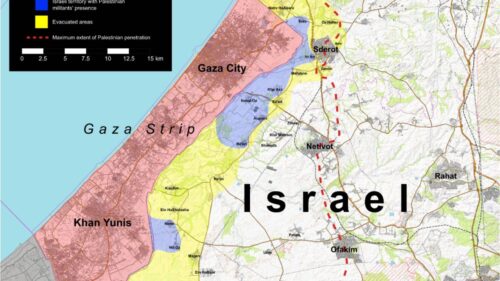On October 7, 2023 (7/10), some 3,000 thousand Hamas terrorists invaded Israeli communities and army bases near Gaza. They killed around 1,200 people — most of them civilians — took some 240 persons hostage to Gaza.
Since the day of the massacre, many fragments of information have come to the surface, revealing that for years the political and military leadership at all levels have erred in recognizing the upcoming threat — sometimes by miscalculation, sometimes by sheer mistake. Although there is a lot of information available, it is all bits and pieces, without any line of thought or direction. My aim is to give them order and thus gain insight into where and when things went wrong in military and civilian policy circles.
Currently, two state inquiries into Israel’s policy and intelligence failures regarding 7/10 are underway. At the end of December 2023, Israel’s State Comptroller, Matanyahu Englman, announced that he will look into all aspects of the failures including examining those with “personal responsibility” for the “failures on all levels — policy, military and civilian.” He stated that his investigation will take up the larger part of 2024. Englman is unwilling to wait for a formal state inquiry committee or for the end of the war. In January 2024, he already submitted a long list of questions to the Israeli Defense Forces (IDF).
Subsequently, in January 2024, Lieutenant General Herzi Halevi, the IDF Chief of Staff and Israel’s highest military actor, formed a team to probe the 7/10 massacre. Though the right-wing part of the coalition government heavily criticized the decision, it seems wise since having an evaluation now could help Israel make correct operational decisions in the current war. Israel is currently fighting Hamas in Gaza and may soon be fighting the terrorist organization Hezbollah in Lebanon, at Israel’s northern border.
Conversely, on the political side, Prime Minister Benjamin Netanyahu has stated that an investigation on the decision-making before and during the Hamas War will only be conducted after the end of the conflict. However, it is unclear when the war against Hamas will end; it may well last the whole year of 2024. Even if the fighting with Hamas were concluded, Israel might still be fighting Hezbollah. Besides, the outcomes of such a state investigation could take years.
In the current absence of results of state inquiry commissions, I will deliver a preliminary analysis of the Israeli policy and intelligence failings. Why preliminary? First of all, because the Hamas War is ongoing. Secondly, because as a private Israeli citizen, I do not have access to governmental documents; I will have to base my conclusions upon media reports.
Methodology: the levels of warfare
I will apply the “levels of warfare” (or “levels of military operation”) analysis. Scholars of military studies commonly use this schema to describe how national interests are translated into national objectives. States generally use hard military power only in the case of a serious violation of national interests. We examine the way in which they use military power at four descending levels: political strategy, military strategy, operations and tactics. The division into these four levels is not strict; they influence each other, and there is overlap.

The highest level, political strategy or “grand strategy,” involves the coordinated use of all the economic, diplomatic, psychological, military and other political instruments the state has at its disposal to achieve its objectives. The actor at this level is the government of the State of Israel.
At the level of military strategy, we see the use of military means of power to guarantee the security of the state. The actors at this level are the IDF Chief of Staff and the commanders of the different services, i.e. the army, air force and navy.
Operational strategy comprises the execution of particular joint campaigns (conducted by the army, air force and navy) in order to achieve a military-strategic objective. In the current situation, the war against Hamas in Gaza is called Operation Swords of Iron. This operation serves the military strategic objective of the destruction of Hamas.
At the tactical level, individual military units are deployed and operate in combat to achieve the operational aim of a campaign. For example, within Operation Swords of Iron, the 7th Armored Brigade raided a Hamas command center in Gaza.
7/10 scrutinized at the political strategic level
On the eve of 7/10, the Israeli government was convinced that Hamas was deterred from starting a war with Israel. Political and military officials of Israel had frequently stated that Hamas was discouraged from a large conflict with Israel. Aryeh Deri, Member of Knesset and political leader of the ruling coalition party Shas, has admitted that the Israeli political and military leadership failed by not recognizing the Hamas threat. According to Deri, Israel underestimated Hamas’ strength and overestimated the IDF’s military power.
This belief was based upon the fact, among others, that Hamas kept aside from several rounds of conflict between Israel and the terrorist organization Palestinian Islamic Jihad in 2022 and 2023. Hamas had ostensibly learned its lesson from its 2014 and 2021 conflicts with Israel.
Hamas intentionally encouraged Israel to believe it was interested in a quiet situation. They gave the impression that they were focusing on economic build-up and avoiding conflict with Israel. Allegedly, Hamas even provided Israel with intelligence on Palestinian Islamic Jihad to reinforce the impression that they were willing to cooperate with Israel.
At least a year before 7/10, the IDF had acquired a Hamas manual that described how to take control of the Israeli area near Gaza. It explained how the operation was to be conducted (see the operational level below). The manual also described the objective to deceive Israel into inactivity, creating a low threat perception by holding negotiations for some form of long-term arrangement to create a false sense of security while at the same time conducting regular exercises and carrying out small security incidents on the border. The details of the manual were forwarded to senior IDF officers. Their reason for dismissing this threat was that Hamas would not be capable of carrying out such a large-scale attack.
Besides the Hamas attack manual, in spring 2022 Hamas TV broadcasted a series which dramatized a huge assault on Israel with pickup trucks, deactivating IDF communications, kidnapping soldiers and civilians and attacking kibbutzim (rural settlements) and IDF bases, among them the location of the Gaza Division. Presumably, neither news of Hamas’s intent to create a false sense of security (as mentioned in the manual) nor of the attack scenario (as mentioned in the series) ever reached the political decision-makers.
In the summer of 2023, a human source from Gaza informed Israel’s internal security agency, Shin Bet, that Hamas was planning a large attack on Israel soon after Yom Kippur. The information was regarded as irrelevant: Hamas simply could not operate on such a large scale. Consequently, the information did not reach Shin Bet chief Ronen Bar. Obviously, the upper political and military echelons did not hear about it either.
In order to shore up intelligence weaknesses discovered during the Yom Kippur War of 1973, the IDF maintains an intelligence unit of different thinking. The task of Ipcha Mistabra, or the “Devil’s Advocate Unit,” is to doubt intelligence assessments and offer alternative conclusions. In the weeks before 7/10, the head of the Devil’s Advocate Unit sent out a number of warnings to all senior decision-makers in the army and the political echelons, assessing an impending attack by Hamas. The unit thus succeeded in its primary task, contradicting the conventional view shared by intelligence, military and political officials. Senior leadership dismissed the assessment, and Netanyahu has denied receiving the warning.
The military strategic level
The IDF leadership assumed that Hamas was deterred because of the impact of the losses they suffered in the 11-day conflict of May 2021, dubbed by IDF “Operation Guardian of the Walls.” Furthermore, the IDF was convinced that, in that operation, they had destroyed the larger part of Hamas’ underground tunnel network. On 7/10, both assumptions proved to be totally wrong.
On October 6, 2023, some hours before the Hamas attack, the IDF’s most senior officers were alerted to some irregular activities on the Gaza border and that Hamas was preparing to launch an offensive. On the night between October 6 and 7, Herzi Halevi held an encrypted telephone call with the head of the Operations Directorate, Major General Oded Basyuk, and the head of Southern Command, Major General Yaron Finkelman. They discussed reports from military intelligence and from Shin Bet on irregular activities by Hamas.
The head of the IDF’s military intelligence directorate, Aharon Haliva, was not invited for the talk. But even if Haliva had participated in the meeting, his military intelligence would have given no indication of an imminent wide-scale attack by Hamas. Military intelligence estimated that the detected activities by Hamas were likely to be routine exercises, similar to previous months.
Consequently, the nightly meeting only resulted in limited action. Halevi ordered that the reported information be checked. He entertained the possibility that the prevailing assessment may have been wrong. Nevertheless, these doubts did not convince Halevi to prepare for a major Hamas assault.
For the intel check-up, three drones and a combat helicopter were activated. In addition to this, Shin Bet chief Ronen Bar decided to dispatch Tequila teams to the Gaza border. Tequila is an elite undercover unit of Shin Bet, seen as a last resort in stopping one or a few individual terrorists who are already preparing to launch an attack. The use of Tequila teams, thus, confirms that Shin Bet also did not have the impression that a large Hamas offensive was looming.
The IDF thus prepared their defenses around Gaza for limited incursions by small groups of terrorists, not a large-scale invasion by thousands of Hamas operatives. As a result, when 7/10 came the IDF were unprepared to counter such a massive attack. According to standard procedures, battalions are expected to deploy within 24 hours in the event of an invasion, after being forewarned by military intelligence. Clearly, no such warning had gone out before 7/10.
The IDF’s response was slow and disorganized. It took considerable time to comprehend the size of the attack; hence, the initial units deployed were ill-equipped to counter the assault.
The Israeli Air Force (IAF) also missed out on 7/10. Only a pair of combat helicopters was on standby, but they were located in northern Israel. Some unmanned aerial vehicles were quickly deployed in the Gaza area, but they could not cope with the scale of the attack. IAF fighter jets arrived shortly after, but they did not understand what was going on and returned to base without taking any action.
The operational level
The terror manual mentioned above can be considered as Hamas’s operational plan. It mentioned conquering IDF army bases and posts, capturing communities, killing and abducting Israelis and taking hold of the cities of Sderot, Ofakim and Netivot. The vehicles to carry out these tasks would be pickup trucks, motorbikes and hang gliders. Large-scale rocket fire from Gaza was to give cover. The manual accurately described what would happen on 7/10.
Israeli intelligence had further knowledge of Hamas’s operational plans. Allegedly, Aharon Haliva visited Unit 8200, a unit of the IDF Intelligence Corps responsible for signal intelligence. They had signaled an upcoming Hamas attack (see “The tactical level,” below). But the warning was not passed on to Haliva. On the contrary, the assessment that he received suggested that Hamas leader Yahya Sinwar had no intention of causing the situation to deteriorate.
Already in July 2022, an unnamed intelligence officer belonging to the IDF’s Gaza Division gave a briefing on “The Mass Invasion Plan of Hamas.” It described Hamas terror squads invading southern Israel from Gaza, together with engineering teams to breach the border fence on multiple spots. The presentation warned that this invasion constituted a very serious threat to the defense of Israel.
Subsequently, in October 2022, a document drafted in the Gaza Division described in detail the Hamas attack that would take place a year later. This document listed details of the impending Hamas operation, concurrent with those mentioned in the aforementioned Hamas manual in possession of the IDF: invading army bases and kibbutzim, killing, destruction and hostage-taking. This was to be preceded by breaching the fence at several spots, neutralizing the IDF technological warning, communications and remote weapon systems. Hamas would penetrate Israel with pickups, jeeps, motorcycles and paragliders, as well as with boats.
Allegedly, the document was sent to the top of the Military Intelligence Directorate. Its head, Aharon Haliva, was also aware of the contents of the report. Nevertheless, no conclusions were apparently drawn nor any action taken.
On October 1, 2023, the commander of the same Gaza Division ordered a situational assessment, which noted a sharp increase in Hamas drills — six battalions were exercising once or twice a week. The division’s intelligence officer described, on the one hand, the economic benefits for Hamas for absence of violence and, on the other hand, a continuation of disturbances at the Gaza border. However, he assessed that there was a development towards détente and a decrease in disturbances.
How could this intelligence officer come to such a conclusion in the light of a sharp increase in exercise activity by Hamas? What happened with the July 2022 briefing on “The Mass Invasion Plan of Hamas”? Considering the fundamental opposite views, the intel officers most likely of July 2022 and of October 1, 2023 were not the same. Nevertheless, how could such divergent views be held in the same division?
The tactical level
On different occasions, Unit 8200 presented warnings about Hamas preparing for a major assault. In July 2023, they warned that Hamas was conducting large-scale exercises aiming at invading kibbutzim and several Israeli towns near Gaza. In September 2023, personnel from this unit noticed a Hamas military exercise which included preparations for a mass invasion with multiple entry points into Israel. The exercise included the use of vehicles to carry out the attack and practiced taking over Israeli towns. Subsequently, Unit 8200 warned a senior officer that Hamas was preparing a well-organized and planned invasion. However, their warnings were met with disbelief, and the senior officer failed to act on the information.
For at least three months before 7/10, lookouts from the Combat Intelligence Corps had reported on training, unusual activity and preparations near the border. They warned about a number of peculiar activities. For instance, more people who had not been previously observed in the area were arriving; the usual Palestinian farmers had been replaced by others; Hamas members were frequently conducting training sessions, digging holes and placing explosives along the border, et cetera. The lookouts saw furthermore that Hamas operatives had models of a tank and weapons on the Israeli fence; the operatives showed how to blow them up. The lookouts also noticed that the Hamas operatives observed the cameras on the fence and were taking pictures of them.
The lookouts passed information about what they were seeing to intelligence and higher-ranking officers, but were powerless to do more. As with Unit 8200’s findings, the lookouts from the Combat Intelligence Corps too had to experience their senior officers disregarding their warnings and consequently declining to forward them up the chain of command. Beyond this, the lookouts were threatened with legal action if they continued bringing up such alarming reports.
Conclusions
The policy and intelligence failures demonstrate shortcomings throughout the system. Intelligence warnings of a looming assault by Hamas were disregarded at all levels of warfare: warnings by Unit 8200 and lookouts of the Combat Intelligence Corps at the tactical level; Gaza Division intelligence at the operational level; warnings by the Devil’s Advocate Unit at the military and political strategic levels. Leaders were convinced Hamas was sufficiently deterred and interested in maintaining the status quo.
With these policy and intelligence deficiencies in view, we cannot help comparing 7/10 to the 1973 Yom Kippur War, the other war that took Israel by surprise. The big difference, of course, is that in 1973 regular armed forces of neighboring states (Egypt and Syria) attacked Israel, whereas in the current war, paramilitary troops (Hamas) did so.
Nevertheless, similar failures occurred. In 1973, the Israeli government was wary of starting a war. The US government exercised political pressure on Israel to remain the status quo. This likely also played a role in Israel’s reluctance to prepare for war or to launch a pre-emptive strike in spite of several intelligence warnings. Equally, in 2023 the Israeli Government was convinced that Hamas was aimed at a calm relationship with Israel. Thus, the government neglected intelligence warnings on a threat by Hamas and was unprepared for warfare. As in 1973, in 2023 the US government under President Joe Biden was putting pressure on Israel to avoid conflict. In this case, Biden hoped to improve the circumstances of the Palestinians.
After the Six-Day War of 1967, in 1973 Israel considered itself invincible; any enemy would stay far away from IDF’s superior military power. Likewise, after 2014 and 2021, Israel considered itself as having soundly defeated Hamas. As Aryeh Deri has admitted, Israel misjudged the threat.
In the months preceding the Yom Kippur War, Israel received a number of warnings about a potential attack by Syria and Egypt. In the same way, over a year before 7/10, Israel received intelligence reports on a forthcoming assault by Hamas and did not act on them.
In 1973 Israel felt safe and secure behind the Bar Lev Line, a fortified set of defenses along the eastern bank of the Suez Canal, built shortly after the 1967 Six-Day War. But on Yom Kippur, Egypt quickly seized all the fortresses except for one. Similarly, before 7/10 Israel was sure that its high-tech sophisticated barrier with Gaza (consisting of remote controlled electronic signaling, camera surveillance and weapon systems) would be a reliable defense against Hamas. In December 2021, Minister of Defense Benny Gantz had ensured that an expensive, state-of-the-art upgrade to the wall would protect the bordering Israeli communities from terror attacks by Hamas. The fence was supplemented by a number of army bases surrounding Gaza. As with the Bar Lev Line, the fence around Gaza was also sparsely guarded, because the IDF relied on its high-tech capabilities. On 7/10, Hamas rapidly breached the fence at multiple locations and overran most of the army bases.
The inquiry committees of the State Comptroller, the IDF and of the State of Israel will have to deal with the question of why all these intelligence warnings were ignored. Was it out of sheer arrogance — Israel considering itself invincible? Or did the political and military leadership regard all the intelligence warnings that came from below as insignificant because it did not concur with the rosy outlook coming from above? Or were policymakers and senior officers afraid that setting off a false alarm might affect their careers?
Did careers outweigh the security of the nation and the lives of its citizens? Why did Israel not learn from similar failures 50 years earlier in the Yom Kippur War? These questions can only be satisfactorily answered if the political and military leadership of Israel is willing to do some deep soul-searching. Without such an introspection, Israel is likely to make the same mistakes again.
[Anton Schauble edited this piece.]
The views expressed in this article are the author’s own and do not necessarily reflect Fair Observer’s editorial policy.
Support Fair Observer
We rely on your support for our independence, diversity and quality.
For more than 10 years, Fair Observer has been free, fair and independent. No billionaire owns us, no advertisers control us. We are a reader-supported nonprofit. Unlike many other publications, we keep our content free for readers regardless of where they live or whether they can afford to pay. We have no paywalls and no ads.
In the post-truth era of fake news, echo chambers and filter bubbles, we publish a plurality of perspectives from around the world. Anyone can publish with us, but everyone goes through a rigorous editorial process. So, you get fact-checked, well-reasoned content instead of noise.
We publish 2,500+ voices from 90+ countries. We also conduct education and training programs
on subjects ranging from digital media and journalism to writing and critical thinking. This
doesn’t come cheap. Servers, editors, trainers and web developers cost
money.
Please consider supporting us on a regular basis as a recurring donor or a
sustaining member.
Will you support FO’s journalism?
We rely on your support for our independence, diversity and quality.










Comment